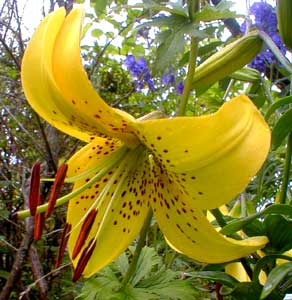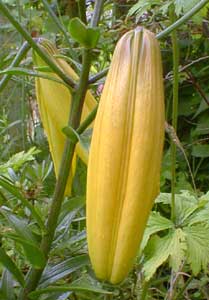
'Yellow Star'
Tiger Lily
"Scarcely one understands that regal, rare,
Bravely the tiger lily blossoms there."
-Walter Adolphe Roberts
(1886-1962)
(1886-1962)
The usual & natural color for tiger lilies is orange to red, with maroon spotting in the throat. But the discovery of Lilium lancifolium var flaviflorum (the outmoded name L. tigrinum is still often used) extended the color range.
Variant "Flaviflorum" became a very important variant for achieving buttery yellows in tiger lilies that are otherwise generally red to orange. The first yellow specimens were probably from Japan. It was not known to western gardening until 1932, & was for a while known by the select strain name 'A. M. Kolmer.'
 "Star" tiger lilies (scarlet, orange, or yellow) have been bred for increased floriferousness & darker speckling. Tge variety 'Yellow Star' produces twelve to twenty dangling flowers on each three to four foot tall lance-leafed stalk. The bright yellow blooms maroon-black freckles & bright orange pistils. The petals are strikingly recurved in the "Turk's-cap" manner. It flowers in early July, a bit ahead of two nearby clumps of L. lancifolium var splendons.
"Star" tiger lilies (scarlet, orange, or yellow) have been bred for increased floriferousness & darker speckling. Tge variety 'Yellow Star' produces twelve to twenty dangling flowers on each three to four foot tall lance-leafed stalk. The bright yellow blooms maroon-black freckles & bright orange pistils. The petals are strikingly recurved in the "Turk's-cap" manner. It flowers in early July, a bit ahead of two nearby clumps of L. lancifolium var splendons.The bulb, flower, or pollin has been used medicinally in the Chinese herbal pharmacopaea, for everything from heart disease to myopia to morning-sickness. Unfortunately its actual efficacy as anything more than a purgative is poorly documented.
The buds dangle with somewhat the resemblance of long waxy yellow peppers, & can be harvested at this stage to be eaten raw or cooked. When they are fully opened they may develop a slight toxicity in the pollin, but the pistils can be removed to use the petals in salads, or the entire flower cooked to break down any toxicity. Of course, gardeners prefer them ornamentally & would rarely take them to eat, least of all before they open into sunny yellow, strongly reflexed, & slightly fragrant flowers of extreme beauty.
But in China & Japan, fields of L. lancifolium are grown as food crops. Besides the sweetish fat buds, the bulbs are also eaten cooked, tasting a bit like parsnips.